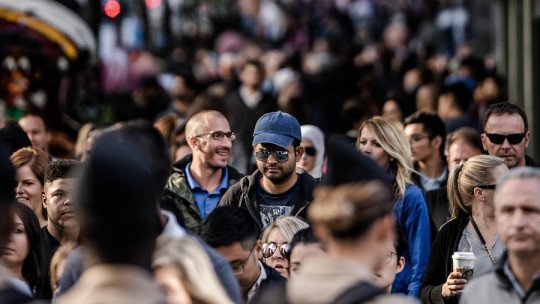
Throughout our lives, we face a whole different network of interactions and experiences of a social nature. When living in societies, it is natural that there are interpersonal differences and that we are affected by the attitudes, behaviors and decisions of other people. It is undeniable, therefore, that All the people who make up a society are influenced by social pressure
Social pressure can be defined as the entire set of expectations and assumption of roles that the group of people who make up a society have on us and determines, to a different extent, our behavior. Social pressure is, on many occasions, the factor that most influences us to make a decision or to act in a certain way.
In this article, you will learn types of social pressure It is important to understand that it can have a very different network of forms and expressions, and each one will influence us in equally significant ways.
Social pressure is an omnipresent force that influences our decisions, behaviors, and even beliefs. Whether we are aware of it or not, the expectations and norms of the society we live in can shape our actions in significant ways. From the clothes we wear to the careers we choose, social pressure can be both a guiding hand and a restrictive force. In this article, we will explore the concept of social pressure, how it manifests in our daily lives, its effects on individuals, and strategies to manage it.
Understanding Social Pressure
Definition of Social Pressure
Social pressure refers to the influence exerted by society, groups, or individuals on a person’s attitudes, beliefs, or behaviors. This influence can be direct, such as through explicit demands or requests, or indirect, through the subtle expectations and norms that shape our actions.
- Direct Pressure: Occurs when individuals are openly encouraged or coerced to conform to certain behaviors or beliefs.
- Indirect Pressure: Involves the unspoken expectations and norms that subtly guide our actions, often without our conscious awareness.
Types of Social Pressure
Social pressure can take various forms, including:
- Peer Pressure: The influence exerted by peers or friends, often leading individuals to conform to group norms or behaviors.
- Cultural Pressure: The expectations and norms dictated by one’s culture, which can shape behaviors, beliefs, and values.
- Media Pressure: The influence of media, including social media, which can set standards for beauty, success, and behavior.
What is social pressure?
To unravel the different ways of presenting and understanding social pressure, it is important to first define this concept itself. Social pressure is a complex phenomenon which we can understand affects individuals and communities at different levels, intensities and aspects. In essence, it refers to the influence that the social environment exerts on people, shaping their thoughts, behaviors and decisions. This invisible force can manifest itself in a variety of ways, from subtle expectations to more explicit demands, and is rooted in the human need to belong and be accepted by society.
In its operation, social pressure encourages people to adhere to cultural norms, shared values and behaviors considered socially acceptable. This conformity may be conscious or unconscious, and its impact may vary depending on the intensity and duration of exposure to social pressure.
One of the crucial aspects of social pressure is its constant presence in everyday life. From childhood, people are exposed to social norms that guide their development and establish expectations about what is considered “normal” or “correct.” These social influences continue throughout the lifespan, affecting decision-making in areas ranging from professional and academic choices to the adoption of gender roles and conformity to aesthetic ideals.
It is important to recognize that social pressure is not always negative. It can be an engine for social progress, promoting cohesion and compliance with ethical standards. However, it can also generate tensions and conflicts when social expectations are restrictive or discriminatory.
The effects of social pressure
Different types of social pressure exert a significant influence on the behavior and well-being of individuals, and their impact extends to different aspects of life. In many cases, it can be a motivating force for conformity and social cohesion, but it can also lead to detrimental effects and emotional challenges.
1. Psychological impact
In terms of psychological impact, social pressure can contribute to stress, anxiety and low self-esteem The constant search for approval and acceptance can take a considerable emotional toll, especially when social norms are demanding or difficult to meet. Additionally, the pressure to conform to certain standards can lead to compromised authenticity and a sense of disconnection from one’s self.
2. Social impact
In the interpersonal sphere, social pressure can influence group dynamics and interpersonal relationships. Conformity sometimes becomes a social survival mechanism, where people adopt specific behaviors to avoid rejection or exclusion. However, this conformity often carries the risk of losing individuality and autonomy in pursuit of social acceptance. At a sociocultural level, social pressure can play a crucial role in perpetuating unfair or discriminatory norms Resistance to challenging these norms can hinder progress towards more inclusive and equitable societies.
3. Importance of identification
However, it is important to highlight that recognition and understanding of social pressure can also be drivers for positive change. Awareness of how these forces influence our lives allows people to make more informed decisions and foster a social environment that promotes diversity and acceptance.
Types of social pressure
Next, we are going to unravel the different types of social pressure that we can find in the social and interpersonal fabric. It is important to consider the differences between them and understand the significant and unique impact that each of these types of social pressure entails. We must also emphasize that each person is different, and therefore, their experience of social pressure can also be closely linked to their personal perception and their situational and social interaction.
1. Conformative pressure
Conformal pressure is a pervasive phenomenon that drives people to conform to social norms and expectations. This type of pressure originates from the natural desire to belong and be accepted by society. Conformity can manifest itself in a variety of ways, from adopting popular fashions and behaviors to repressing individual opinions Although conforming pressure can promote social cohesion, it also poses challenges by limiting authentic expression and diversity of thought.
2. Regulatory pressure
This is one of the easiest types of social pressure to detect. Normative pressure derives from the cultural and social norms that guide accepted behavior in a society. These norms define what is considered appropriate or inappropriate, and their influence can be powerful Normative pressure can influence decisions from clothing to career choices.
Although social norms are essential for coexistence, their rigidity can generate conflicts when they clash with the diversity of individual values.
3. Peer pressure
Peer pressure manifests itself when membership in a group influences individual decisions. Individuals, seeking acceptance and connection, may defer to group expectations, even if they differ from their own beliefs This dynamic can be both positive and negative: it fosters social cohesion but can also lead to non-reflective conformity. Understanding how peer pressure operates is essential to balancing individual and collective identity in social contexts.
4. Peer pressure
Peer pressure manifests itself in the influence that friends and colleagues exert on individual decisions. In search of acceptance and belonging, people may adopt behaviors, fashions, or attitudes similar to those of their peer group. This dynamic may be particularly strong during adolescence, but persists throughout life. Although peer pressure can provide social support, it can also lead to impulsive decisions or following unhealthy tendencies.
5. Gender pressure
Gender pressure manifests itself through the expectations and norms associated with gender roles. From an early age, societies impose ideas about how men and women are expected to behave, dress, and pursue their careers. This type of pressure can limit individual freedom and perpetuate stereotypes Challenging gender norms often means facing social resistance. Understanding gender pressure is essential to fostering equality and authenticity in the expression of gender identity.
6. Family pressure
Family pressure originates from the expectations and values that the family imposes on its members. From childhood, families transmit cultural, religious and social norms that influence individual choices Although this pressure can come from a place of love and care, it can also lead to conflict when individual aspirations clash with family expectations. Navigating family pressure involves finding a balance between respect for traditions and personal autonomy.
7. Cultural pressure
Cultural pressure emanates from the norms, values and expectations embedded in a specific society. Every culture shapes perceptions about morality, success, and identity. Cultural pressure can influence individual decision-making and perpetuate traditional practices. However, can be challenging when these norms conflict with social evolution Recognizing and challenging cultural pressure is essential to fostering diversity and intercultural understanding
8. Media pressure
Media pressure is manifested through the influence of the media on social perception and individual decisions. Images, messages and beauty standards transmitted through the media can impact people’s self-esteem and choices.
Media pressure not only affects body image, but also opinions, lifestyles and values The ability to discern between reality and media representation is essential to resist the not always realistic influence of the media.
How Social Pressure Manifests
Peer Pressure
Peer pressure is one of the most common forms of social pressure, especially among adolescents and young adults. It can lead to both positive and negative behaviors.
- Positive Peer Pressure: Encouraging someone to study, exercise, or engage in healthy behaviors.
- Negative Peer Pressure: Pushing someone to engage in risky or harmful activities, such as drug use or reckless behavior.
Cultural Expectations
Cultural expectations can exert a powerful influence on individuals, dictating everything from career choices to family dynamics.
- Gender Roles: Cultural norms around gender can pressure individuals to conform to traditional roles, such as women being expected to focus on homemaking and men on providing for the family.
- Marriage and Family: In some cultures, there is significant pressure to marry by a certain age or to have children, which can lead to stress and dissatisfaction.
Media Influence
The media plays a significant role in shaping societal norms and expectations. From fashion trends to body image, media can create unrealistic standards that people feel pressured to meet.
- Social Media: Platforms like Instagram and TikTok can amplify social pressure by presenting curated, often unrealistic portrayals of life, leading individuals to compare themselves unfavorably to others.
- Advertising: Advertisements often promote idealized images of beauty, success, and happiness, contributing to feelings of inadequacy among viewers.
Effects of Social Pressure
Positive Effects
Not all social pressure is harmful. In some cases, it can lead to positive outcomes.
- Encouraging Growth: Social pressure can motivate individuals to improve themselves, such as through education, career advancement, or personal development.
- Promoting Social Harmony: Conforming to social norms can help maintain order and harmony within a community, ensuring that individuals behave in ways that are acceptable to society.
Negative Effects
However, social pressure can also have detrimental effects, particularly when it leads to stress, anxiety, or unhealthy behaviors.
- Loss of Individuality: Excessive social pressure can cause individuals to suppress their true selves in favor of conforming to societal expectations, leading to a loss of personal identity.
- Mental Health Issues: The constant pressure to meet societal standards can contribute to stress, anxiety, and depression, particularly when individuals feel they cannot measure up.
- Risky Behaviors: Peer pressure, in particular, can lead individuals to engage in risky or harmful behaviors, such as substance abuse or reckless driving.
Strategies to Manage Social Pressure
Building Self-Awareness
The first step in managing social pressure is to develop self-awareness. By understanding your values, beliefs, and goals, you can better resist the influence of external pressures.
- Reflect on Personal Values: Take time to consider what is truly important to you, rather than what society or others expect of you.
- Set Personal Goals: Establishing clear, personal goals can help you stay focused on what matters to you, reducing the impact of social pressure.
Developing Resilience
Building resilience is key to managing social pressure. This involves developing the ability to withstand and recover from the stress and challenges that pressure can bring.
- Practice Assertiveness: Learning to say no and standing up for your beliefs can help you resist social pressure and maintain your integrity.
- Seek Support: Surrounding yourself with supportive friends and family can provide a buffer against social pressure, helping you stay true to yourself.
Critical Thinking
Critical thinking involves analyzing and evaluating information before accepting it as truth. This skill is essential in resisting the influence of social pressure, particularly when it comes from media or cultural norms.
- Question Norms: Don’t automatically accept societal norms as right or necessary. Question why they exist and whether they align with your values.
- Evaluate Media Messages: Be critical of the messages you receive from media sources. Consider the motives behind them and whether they reflect reality.
Social pressure is a powerful force that can shape our behaviors, beliefs, and decisions. While it can sometimes lead to positive outcomes, it also has the potential to harm our mental health and individuality. By developing self-awareness, resilience, and critical thinking skills, we can better manage social pressure and live more authentic lives. Understanding the influence of social pressure is the first step in taking control of our own choices and actions.
FAQs
What is social pressure?
Social pressure refers to the influence that society, groups, or individuals exert on a person’s attitudes, beliefs, or behaviors, often leading them to conform to certain norms or expectations.
How does peer pressure differ from other forms of social pressure?
Peer pressure specifically involves influence from friends or peers, while other forms of social pressure can come from cultural expectations, media, or societal norms.
Can social pressure have positive effects?
Yes, social pressure can encourage personal growth and promote social harmony by motivating individuals to improve themselves and behave in ways that are acceptable to society.
How can I resist social pressure?
Resisting social pressure involves building self-awareness, developing resilience, and practicing critical thinking to stay true to your values and beliefs.
What role does the media play in social pressure?
The media plays a significant role in shaping societal norms and expectations, often creating unrealistic standards that people feel pressured to meet.








